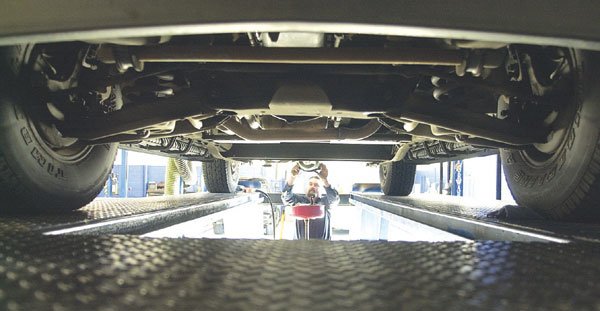When Bob Tiffany’s family settled in Hollister in 1910, there
were more hooves on the road than tires. But E.W. Tiffany, Bob’s
great-grandfather, was soon to begin his role in tipping the scales
in favor of the horseless carriage throughout the South County.
Mike De Give
Special to South Valley Newspapers
When Bob Tiffany’s family settled in Hollister in 1910, there were more hooves on the road than tires. But E.W. Tiffany, Bob’s great-grandfather, was soon to begin his role in tipping the scales in favor of the horseless carriage throughout the South County.
E.W. was a real estate broker with a lot of ground to cover, showing ranches to prospective buyers all over San Mateo County. He bought his first Model T – from a personal friend of Henry Ford. It turns out he was so impressed with the vehicle that he started his own dealership on the side, in Hollister, and began laying the groundwork for four generations of car dealers to do business in the South Valley.
“We’re now the oldest Ford dealership in California, and I believe the seventh oldest in the country,” said Tiffany, who got behind the wheel of the family business – Tiffany Motor Co. – in 1987.
Nearly 100 years later, the automobile is an inescapable fact of life, contributing its own lexicon to American culture with phrases like “traffic jam,” “gridlock” and “sticker shock.” But cars have also become increasingly important to local cities that have grown to depend upon auto sales as a major source of tax revenue, and to workers of all economic levels as a source of jobs.
Driving the local economy
Hollister may be home to the area’s oldest car dealership, but Gilroy has clearly taken the lead as the auto capitol of South Santa Clara County. The city is now home to nine new-car dealerships. Seven are located in the auto mall, replete with American flags, red-white-and-blue bunting and flood lights that erase the dark with a glare as bright as a Las Vegas Casino.
Last year, $180 million changed hands on these lots as customers from the Bay Area and Monterey Peninsula embraced monthly payments and cheap financing to drive home in thousands of brand-new Toyotas, Cadillacs, Volkswagens and Buicks. Even with sales down significantly from previous years, the deals reaped $1.8 million for the city of Gilroy – accounting for 19.5 percent of the city’s entire take of sales tax revenue. Only Gilroy’s outlets, another regional draw, generated as much in sales tax, said Irma Navarro, revenue officer for the City of Gilroy. Sales in Gilroy reached $2.2 million in 2000, held steady in 2001 and dipped to $2.1 million in 2002.
The Gilroy Auto Mall alone paid more than 300 salaries to a range of workers last year, with annual paychecks that averaged about $55,000, according to California’s Employment Development Department. Morgan Hill’s sole auto dealer, Courtesy Chevrolet, put 40 people to work, and Hollister’s auto dealers, all told, employed about 100 workers.
Dealerships provide an assortment of jobs, from entry-level car washers and clerical workers to finance specialists and sales executives.
“There are seven different departments in this dealership, and I run all seven of them,” said Frank Bolea, owner of Gilroy Toyota-Scion, which employs 80. Along with the Honda store, Bolea’s was the first dealership to move into the auto mall in 1988.
With the combination of sales tax and job offerings, most local governments are eager to have car dealers move into their city limits – even while some residents may be against the idea. Morgan Hill is currently debating whether to encourage as many as 10 dealerships to take up residence near U.S. 101.
“One new auto dealer can produce $200,000 to $300,000 of annual sales tax revenue, and that’s a lot of money for most cities,” said Jack Dilles, finance director for the city of Morgan Hill. “So you can see if you had 10 of them you might get $2 million to $3 million in revenue each year, just from the 1 percent of the tax that comes to the city.”
Competitive market
More dealerships will also increases competition among players already in the market. Some welcome the newcomers, such as a Ford dealership proposed east of U.S. 101 in Morgan Hill, saying the traffic at one dealership is good for neighboring business.
“As soon as that Ford dealer goes into business, my business will go up, I guarantee you,” said John Anderson, who opened Courtesy Chevrolet in Morgan Hill in December. “Just because he’ll advertise, he’ll attract people to Morgan Hill and they’ll see my store. And I’ll attract people who will see his store. Together we’ll attract a lot of business, I think.”
Others say there’s not enough business to support more dealerships than the area already has.
“Morgan Hill doesn’t need any new stores, and what they’ve got there they shouldn’t have,” Bolea said. “They’ve got a Chevy store there, a Chevy store here, a Chevy store in Hollister – and they’re all going broke. Every Chevy store within a 30 mile radius sold out in the last year and a half. Why do you think they do that? They’re going broke.”
Sales slump
In fact, the auto industry as a whole has taken a beating in the marketplace the last few years, particularly in the Bay Area, where sales last year were down 17 percent compared to 2002, and 42 percent below the peak of sales in 2000.
But not everyone felt the pain equally, local dealers said.
“It depends where you are and what product lines you’re selling,” Gilroy Chevrolet-Cadillac dealer Sheila Martin said. “Things seemed to drop in California for non-import dealers. Import dealers didn’t seem to be as badly hit as Ford, Chevy, Chrysler. The Greater Bay Area seems to be interested in a lot of imports.”
Marty Greenwood, who operates Greenwood Chevrolet in Hollister, sees this same foreign/domestic sales disparity among the different dealerships in the South County Auto Group, to which his store belongs.
“Our Nissan store is actually up this year versus last year, comparing the first two months of the year,” he said. “I have a lot of friends in the business, and I see that the imports are holding their own. But I also see that the stores all across the Bay Area and San Benito County and Monterey County and Santa Cruz County are down, year over year.”
Paul Taylor, an economist with the National Auto Dealers Association, acknowledges a downturn in auto sales nationwide, but says the decline should be measured, in part, by how high the market had climbed. The years preceding 2002 were phenomenal years for car sales, he said. In 1999, American dealers sold 16.9 million units, up from 15.5 million the year before. In 2000, sales climbed 2 percent to 17.4 million, an all-time high. By 2001, sales had dropped slightly to 17.1 million, but remained significantly higher than the relatively flat sales figures that had been reported for several decades, which averaged about 15.5 million and topped 16 million only once, he said. Many 2001 sales were attributed to zero-percent financing offered in the fourth quarter, following September’s terrorist attacks.
“We think sales are pretty strong compared to that long history, and reasonable considering they are following the five strongest years in history, back to back,” Taylor said.
The Super highway
The economic climate in the auto industry may make for fiercer competition among rivals, but may ultimately serve the consumer, some local dealers say. New car prices have dropped three years running, driven for a time by a stronger dollar.
Moreover, consumers are turning more and more to the Internet to educate themselves in what different brands have to offer, and are coming into dealerships knowing how much a car should cost, what kind of financing is available and what options they want.
“The biggest impact on the car business has been the Internet,” said Anderson, who sells about 20 percent of the Chevrolets at his San Jose store to customers who started shopping online. “Other than getting in and smelling it and test-driving it, you can find out everything you want to know about any car, right from your living room.”
Martin, who opened her Gilroy Chevy store only recently, said many of her customers are doing their homework online before coming into the showroom.
“Customers are very knowledgeable when they come to you, so you need to make sure your salesmen are trained well to handle very knowledgeable shoppers. You don’t want to have your shopper more knowledgeable than your sales person.”
The National Association of Auto Dealers predicts the decline in new car sales will slow mid-year, with the market gaining ground in 2005.
Local dealers like Greenwood are also hopeful the trend will reach to California, which often lags behind the nation in economic recovery.
“We’re four years into this jog, and it’s due to hit, it’s just due to hit,” he said.













